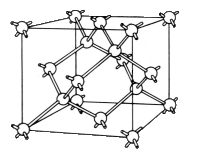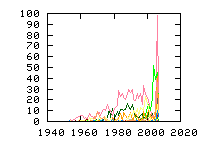« Previous
1
Next »
(15 hits, 1/1)
Showing
10, 25, 50, 100, 500, 1000, all papers per page.
Sort by:
last publication date,
older publication date,
last update date.
- 1. Phys. Rev. B 75, 035211 (2007) , “Self- and foreign-atom diffusion in semiconductor isotope heterostructures. II. Experimental results for silicon”, H. Bracht, H. H. Silvestri, I. D. Sharp, and E. E. HallerWe report the diffusion of boron, arsenic, and phosphorus in silicon isotope multilayer structures at temperatures between 850 °C and 1100 °C. The diffusion of all dopants and self-atoms at a given temperature is modeled with the same setting of all native-point-defect-related parameters.... (Read more)
- 2. Phys. Rev. B 75, 014102 (2007) , “First-principles study of vacancy formation in hydroxyapatite”, Katsuyuki Matsunaga and Akihide KuwabaraFirst-principles plane-wave calculations were performed for hydroxyapatite (HAp) in order to investigate the electronic structure and vacancy formation mechanisms. The HAp unit cell contains PO4 tetrahedra and OH groups formed by covalent P-O and H-O bonds. Ca ions play a role for... (Read more)
- 3. Phys. Rev. B 74, 153403 (2006) , “Doping and the unique role of vacancies in promoting the magnetic ground state in carbon nanotubes and C60 polymers”, Antonis N. Andriotis, R. Michael Sheetz, and Madhu MenonThe role of various types of defects in establishing the magnetic properties of the C60-based polymers and the single-wall carbon nanotubes is investigated. Comparing the role of carbon vacancies, and that of substitutional impurity atoms X (X=N, B, O, Si, P, and S) in... (Read more)
- 4. Phys. Rev. B 73, 193203 (2006) , “Theoretical study of the phosphorus vacancy in ZnGeP2”, Xiaoshu Jiang, M. S. Miao, and Walter R. L. LambrechtFirst-principles calculations are presented for the phosphorus vacancy VP in ZnGeP2, using full-potential linearized muffin-tin orbital supercell local density functional theory calculations. We find the VP to have a high energy of formation compared to... (Read more)
- 5. Phys. Rev. Lett. 97, 226401 (2006) , “Quasiparticle Corrections to the Electronic Properties of Anion Vacancies at GaAs(110) and InP(110)”, Magnus Hedström, Arno Schindlmayr, Günther Schwarz, and Matthias SchefflerWe propose a new method for calculating optical defect levels and thermodynamic charge-transition levels of point defects in semiconductors, which includes quasiparticle corrections to the Kohn-Sham eigenvalues of density-functional theory. Its applicability is demonstrated for anion vacancies at... (Read more)
- 6. Phys. Rev. B 70, 085202 (2004) , “Reassignment of phosphorus-related donors in SiC”, E. Rauls, M. V. B. Pinheiro, S. Greulich-Weber, and U. GerstmannCombining efficient density-functional based tight-binding molecular dynamics with ab initio calculations, we show that despite higher formation energies the incorporation of phosphorus at the carbon sublattice is favored by kinetic effects during the annealing processes. Based on the... (Read more)
- 7. Phys. Rev. Lett. 93, 255502 (2004) , “Formation of Thermal Vacancies in Highly As and P Doped Si”, V. Ranki and K. SaarinenUsing positron annihilation measurements we observed the formation of thermal vacancies in highly As and P doped Si. The vacancies start to form at temperatures as low as 650 K and are mainly undecorated at high temperatures. Upon cooling the vacancies form stable vacancy-impurity complexes such as... (Read more)
- 8. Phys. Rev. B 61, 12602 (2000) , “Phosphorus-related deep donor in SiC”, A. Gali, P. De?k, P. R. Briddon, R. P. Devaty, W. J. ChoykeTwo phosphorus centers in SiC, an isolated P atom substituting for Si (PSi) and a Si-site P-atom adjacent to a carbon vacancy (PSi+VC) are investigated by first principle calculations. It is shown that PSi+VC produces a singly occupied donor... (Read more)
- 9. Proc. symp. on the degradation od electronic devices due to device operation as well as crystalline and process-induced defects 94-1, 221-234 (1994) , ECS (ISBN:1-56677-037-8) , “Spin dependent recombination in Si p-n junctions”, B. K. Meyer , P. Christmann , W. Stadler, H. Overhof, J.-M. Spaeth, S. Greulich-Weber, B. Stich
- 10. Phys. Rev. B 46, 12335 (1992) , “Microscopic mechanism of atomic diffusion in Si under pressure ”, Osamu Sugino and Atsushi OshiyamaWe have performed the first-principles total-energy calculations on the atomic diffusion of group-V impurities in Si, and have revealed the pressure effect on the activation energy of the diffusion. For the vacancy mechanism, the activation energies for P, As, and Sb decrease with pressure. For the... (Read more)
- 11. Lattice Defects in Semiconductors 23, 1-22 (1975) , Institute of Physics, London , “EPR Studies of the Lattice Vacancy and Low-Temperature Damage Processes in Silocon”, G. D. Watkins.EPR studies of silicon irradiated at 20.4 K and 4.2 K by 1.5 MeV and 46 MeV electrons are described. In 46 MeV irradiations the dominant defects formed appear to be divavancies and other multiple defect aggregates which liberate vacancies throughout the anneal to room temperature as they reorder, recombine, etc. For 1.5 MeV irradiations group III atoms play a vital role in p- and n-type materials in trapping interstitials and stabilizing damage. Carbon and oxygen are not effective interstitial traps at these temperatures. Evidence of limited vacancy migration during irradiation is also cited. Two distinct excited configurations of vacancy-oxygen pairs are identified as precursors to A-centre formation in n-type silicon. The kinetics for their conversion to A-centres depends strongly upon the Fermi level as does the isolated vacancy migration energy whhich is measured to be 0.18 ± 0.02 eV for the V= charge state. The vacancy has four charge states, V+, V0, V- and V=. Kinetics for hole release from V+ reveals an activation barrier of 0.057 eV. The concentration of V+ at 20.4 K in boron-doped material indicates the corresponding donor level even closer to the band edge, approximately EV + 0.039 eV. Jahn-Teller energies for V0, V+, and V- are estimated from stress-alignment studies and confirmed to be large. Kinetics studies for reorientation from one Jahn-Teller distortion to another are also described for each charge state.
- 12. Solid State Commun. 16, 171 (1975) , “On the Role of Defect Charge State in the Stability of Point Defects in Silicon”, L. C. Kimerling, H. M. DeAngelis, J. W. Diebold.Defect annealing in 1-MeV electron-irradiated, phosphorus-doped silicon is studied. Charge state effects are explored directly using a p-n junction structure. A defect state which is associated with the E center (phosphorus-vacancy pair) is found to disappear at approximately 150°C with an... (Read more)
- 13. Phys. Rev. B 9, 4351-4361 (1974) , “EPR study of defects in neutron-irradiated silicon: Quenched-in alignment under <110>-uniaxial stress”, Young-Hoon Lee and James W. CorbettThe stress effect in an EPR study is first treated rigorously in terms of the piezospectroscopic tensor, taking account of the local symmetry of a defect. It is found that the degree of alignment (n?/n?) provides incisive information on the structure of a defect; in general, a... (Read more)
- 14. J. Appl. Phys. 43, 3499-3506 (1972) , “Electron Paramagnetic Resonance of the lattice Damage in Oxygen-Implanted Silicon”, K.L. Brower and Wendland BeezholdThe nature of the lattice damage produced at room temperature in ion-implanted intrinsic and n-type silicon has been studied as a function of 160-keV O+ ion fluence using electron paramagnetic resonance (EPR). The known EPR spectra observed were the negative divacancy (Si-G7), the... (Read more)Si| EPR ion-implantation neutron-irradiation| 31P D G7 Oxygen P3 Phosphorus S1 S2 SL2 Silicon amorphous vacancy .inp files: Si/SL2 | last update: Takahide Umeda
- 15. Phys. Rev. 134, A1359 (1964) , “Defects in Irradiated Silicon: Electron Paramagnetic Resonance and Electron-Nuclear Double Resonance of the Si-E Center”, G. D. Watkins, J. W. Corbett.The Si-E center is one of the dominant defects produced by electron irradiation in phosphorus-doped vacuum floating zone silicon. It introduces an acceptor level at ?(Ec-0.4) eV and gives rise to an electron paramagnetic resonance when this level does not contain an electron. As a result... (Read more)
« Previous
1
Next »
(15 hits, 1/1)
Showing
10, 25, 50, 100, 500, 1000, all papers per page.
Sort by:
last publication date,
older publication date,
last update date.
All papers (3399)
Updated at 2010-07-20 16:50:39
Updated at 2010-07-20 16:50:39
(view as: tree
,
cloud
)
| 1329 | untagged |
Materials
(111 tags)
Others(101 tags)
Technique
(46 tags)
Details
(591 tags)
Bond(35 tags)
Defect(interstitial)(18 tags)
Defect(vacancy)(15 tags)
Defect-type(19 tags)
Element(65 tags)
Energy(8 tags)
Isotope(56 tags)
Label(303 tags)
Sample(17 tags)
Spin(8 tags)
Symmetry(15 tags)

